Organizational Strategy and Planning for Zara: A Comprehensive Report
VerifiedAdded on 2020/03/13
|9
|1791
|171
Report
AI Summary
This report provides a comprehensive analysis of Zara's organizational strategy and planning. It begins with an organizational review, highlighting Zara's global presence, product offerings, supply chain, and financial performance. A detailed SWOT analysis is conducted to evaluate Zara's internal strengths and weaknesses, as well as external opportunities and threats. The report then explores strategies for maintaining a competitive advantage in the future, emphasizing the importance of innovation, competitor analysis, and customer responsiveness. It outlines specific recommendations for strategy formation, including creating original designs, targeting new markets, and leveraging e-commerce. The report concludes with a discussion of strategy implementation and evaluation, suggesting the hiring of new designers, expanding e-commerce operations, implementing advertising campaigns, and utilizing social media for customer engagement and feedback. The effectiveness of these strategies is to be evaluated by analyzing customer base growth and sales revenue.
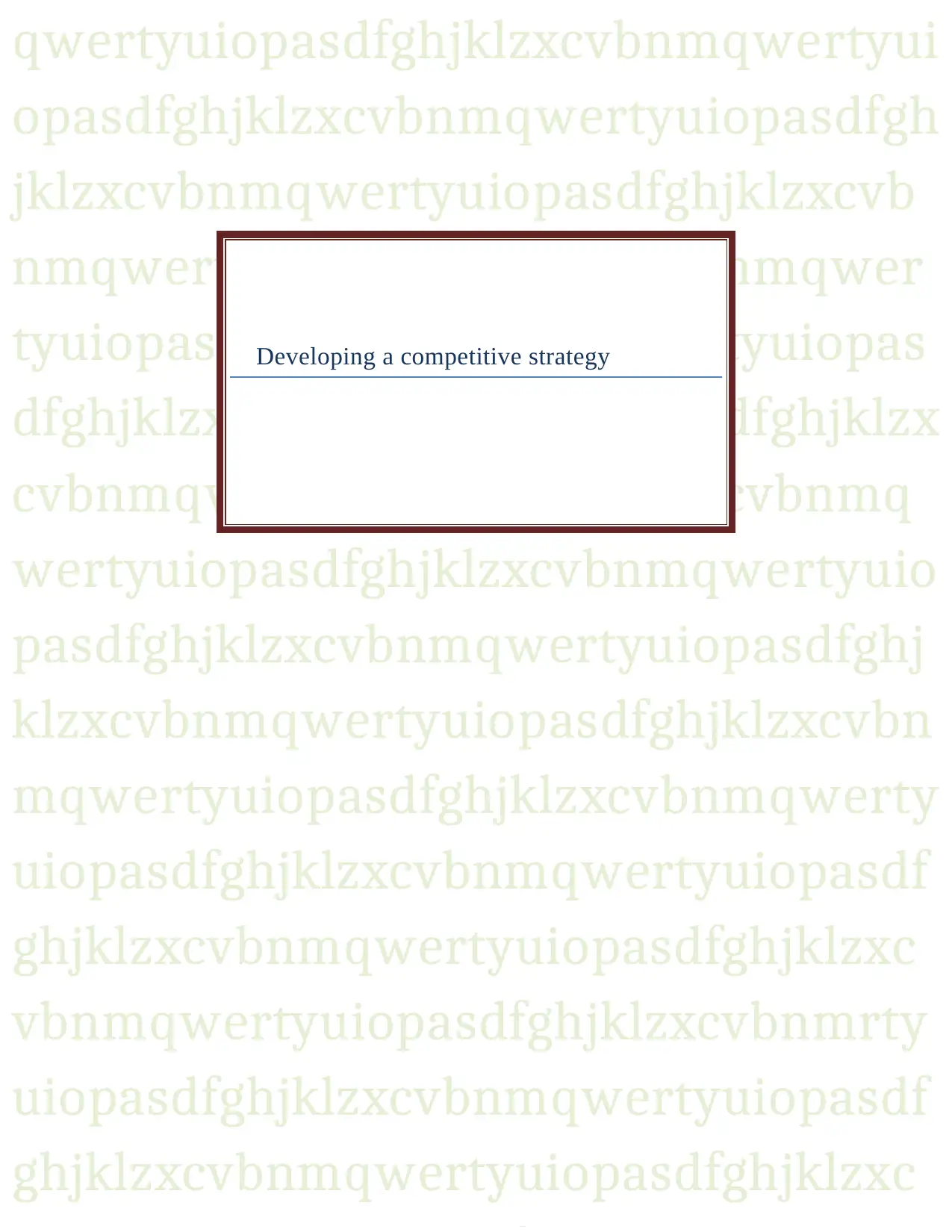
qwertyuiopasdfghjklzxcvbnmqwertyui
opasdfghjklzxcvbnmqwertyuiopasdfgh
jklzxcvbnmqwertyuiopasdfghjklzxcvb
nmqwertyuiopasdfghjklzxcvbnmqwer
tyuiopasdfghjklzxcvbnmqwertyuiopas
dfghjklzxcvbnmqwertyuiopasdfghjklzx
cvbnmqwertyuiopasdfghjklzxcvbnmq
wertyuiopasdfghjklzxcvbnmqwertyuio
pasdfghjklzxcvbnmqwertyuiopasdfghj
klzxcvbnmqwertyuiopasdfghjklzxcvbn
mqwertyuiopasdfghjklzxcvbnmqwerty
uiopasdfghjklzxcvbnmqwertyuiopasdf
ghjklzxcvbnmqwertyuiopasdfghjklzxc
vbnmqwertyuiopasdfghjklzxcvbnmrty
uiopasdfghjklzxcvbnmqwertyuiopasdf
ghjklzxcvbnmqwertyuiopasdfghjklzxc
Developing a competitive strategy
opasdfghjklzxcvbnmqwertyuiopasdfgh
jklzxcvbnmqwertyuiopasdfghjklzxcvb
nmqwertyuiopasdfghjklzxcvbnmqwer
tyuiopasdfghjklzxcvbnmqwertyuiopas
dfghjklzxcvbnmqwertyuiopasdfghjklzx
cvbnmqwertyuiopasdfghjklzxcvbnmq
wertyuiopasdfghjklzxcvbnmqwertyuio
pasdfghjklzxcvbnmqwertyuiopasdfghj
klzxcvbnmqwertyuiopasdfghjklzxcvbn
mqwertyuiopasdfghjklzxcvbnmqwerty
uiopasdfghjklzxcvbnmqwertyuiopasdf
ghjklzxcvbnmqwertyuiopasdfghjklzxc
vbnmqwertyuiopasdfghjklzxcvbnmrty
uiopasdfghjklzxcvbnmqwertyuiopasdf
ghjklzxcvbnmqwertyuiopasdfghjklzxc
Developing a competitive strategy
Paraphrase This Document
Need a fresh take? Get an instant paraphrase of this document with our AI Paraphraser
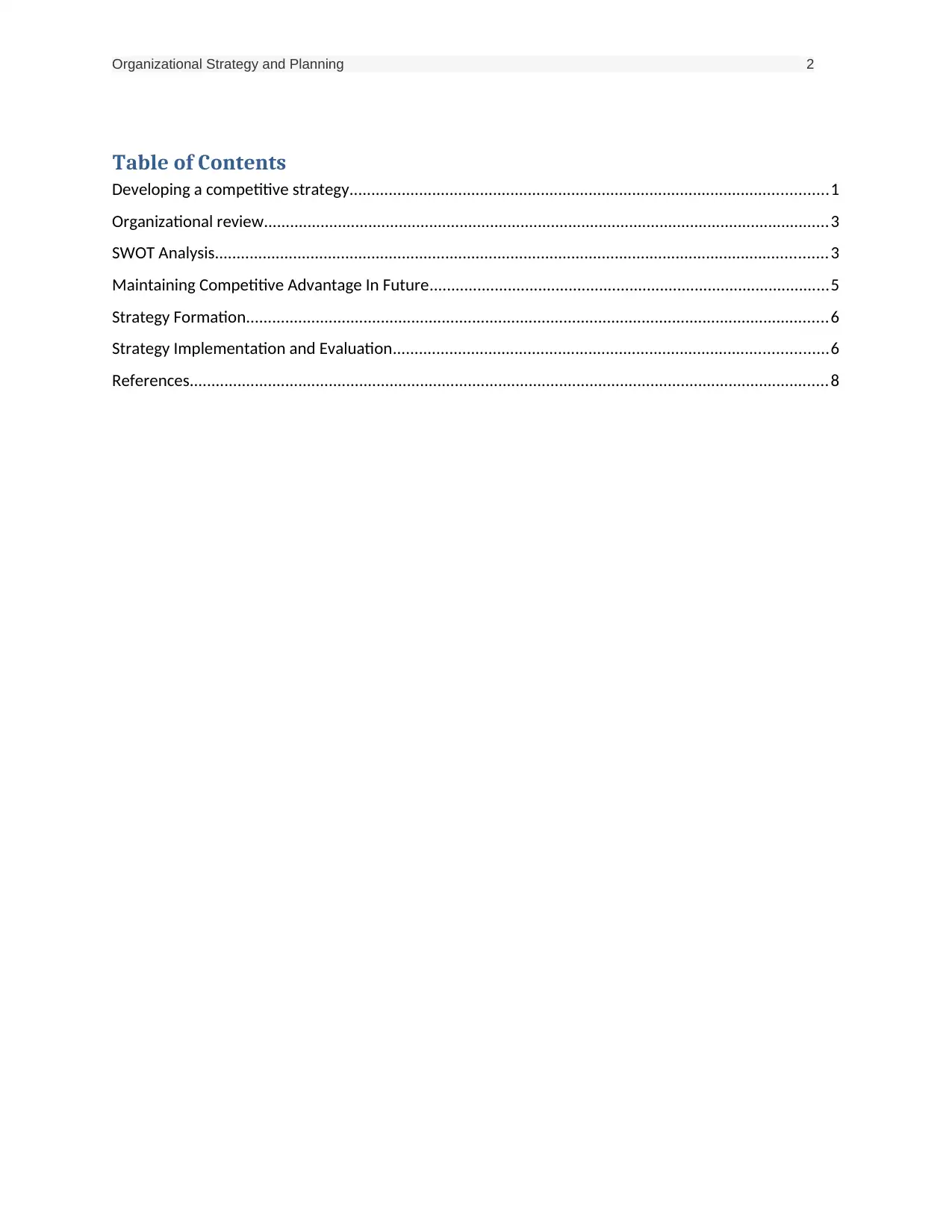
Organizational Strategy and Planning 2
Table of Contents
Developing a competitive strategy..............................................................................................................1
Organizational review..................................................................................................................................3
SWOT Analysis.............................................................................................................................................3
Maintaining Competitive Advantage In Future............................................................................................5
Strategy Formation......................................................................................................................................6
Strategy Implementation and Evaluation....................................................................................................6
References...................................................................................................................................................8
Table of Contents
Developing a competitive strategy..............................................................................................................1
Organizational review..................................................................................................................................3
SWOT Analysis.............................................................................................................................................3
Maintaining Competitive Advantage In Future............................................................................................5
Strategy Formation......................................................................................................................................6
Strategy Implementation and Evaluation....................................................................................................6
References...................................................................................................................................................8
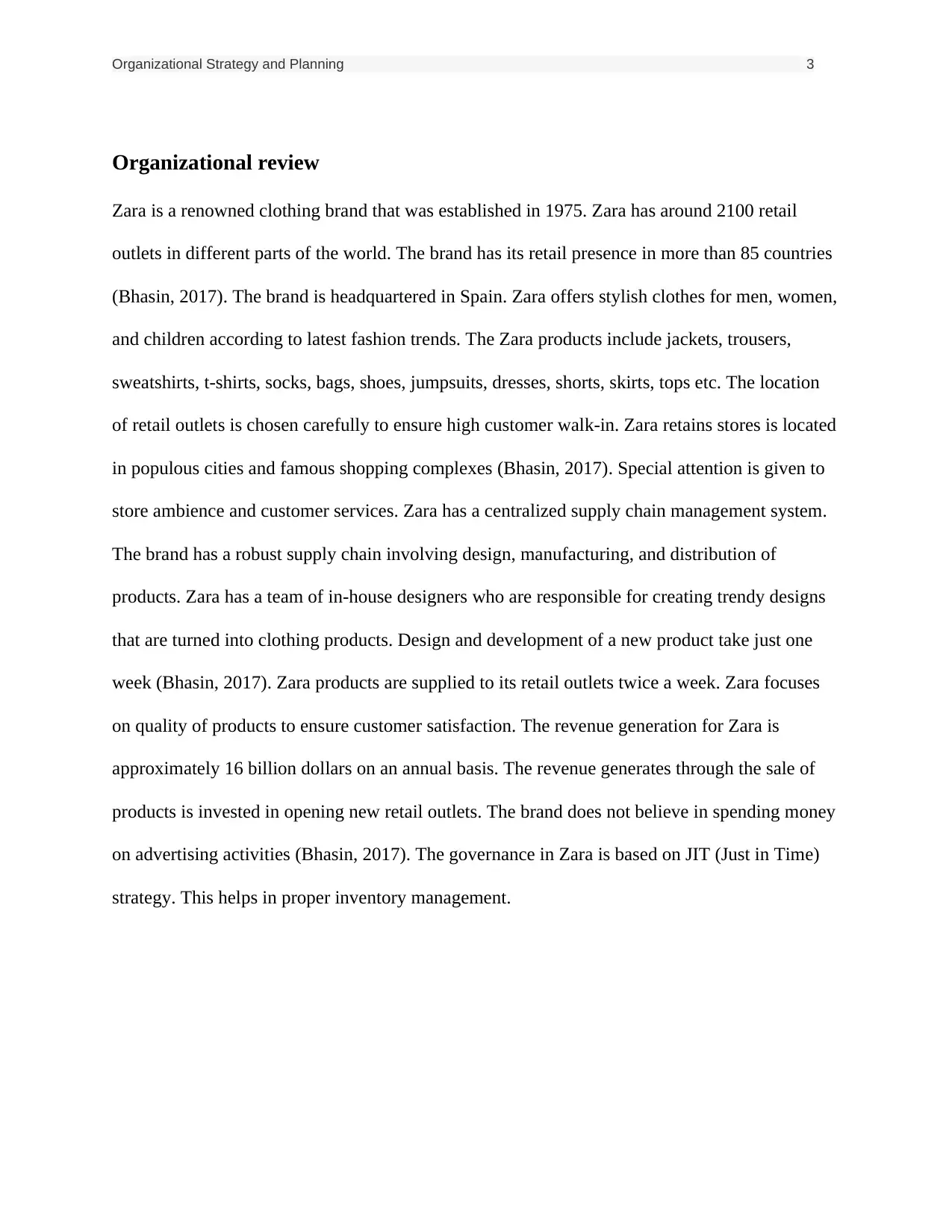
Organizational Strategy and Planning 3
Organizational review
Zara is a renowned clothing brand that was established in 1975. Zara has around 2100 retail
outlets in different parts of the world. The brand has its retail presence in more than 85 countries
(Bhasin, 2017). The brand is headquartered in Spain. Zara offers stylish clothes for men, women,
and children according to latest fashion trends. The Zara products include jackets, trousers,
sweatshirts, t-shirts, socks, bags, shoes, jumpsuits, dresses, shorts, skirts, tops etc. The location
of retail outlets is chosen carefully to ensure high customer walk-in. Zara retains stores is located
in populous cities and famous shopping complexes (Bhasin, 2017). Special attention is given to
store ambience and customer services. Zara has a centralized supply chain management system.
The brand has a robust supply chain involving design, manufacturing, and distribution of
products. Zara has a team of in-house designers who are responsible for creating trendy designs
that are turned into clothing products. Design and development of a new product take just one
week (Bhasin, 2017). Zara products are supplied to its retail outlets twice a week. Zara focuses
on quality of products to ensure customer satisfaction. The revenue generation for Zara is
approximately 16 billion dollars on an annual basis. The revenue generates through the sale of
products is invested in opening new retail outlets. The brand does not believe in spending money
on advertising activities (Bhasin, 2017). The governance in Zara is based on JIT (Just in Time)
strategy. This helps in proper inventory management.
Organizational review
Zara is a renowned clothing brand that was established in 1975. Zara has around 2100 retail
outlets in different parts of the world. The brand has its retail presence in more than 85 countries
(Bhasin, 2017). The brand is headquartered in Spain. Zara offers stylish clothes for men, women,
and children according to latest fashion trends. The Zara products include jackets, trousers,
sweatshirts, t-shirts, socks, bags, shoes, jumpsuits, dresses, shorts, skirts, tops etc. The location
of retail outlets is chosen carefully to ensure high customer walk-in. Zara retains stores is located
in populous cities and famous shopping complexes (Bhasin, 2017). Special attention is given to
store ambience and customer services. Zara has a centralized supply chain management system.
The brand has a robust supply chain involving design, manufacturing, and distribution of
products. Zara has a team of in-house designers who are responsible for creating trendy designs
that are turned into clothing products. Design and development of a new product take just one
week (Bhasin, 2017). Zara products are supplied to its retail outlets twice a week. Zara focuses
on quality of products to ensure customer satisfaction. The revenue generation for Zara is
approximately 16 billion dollars on an annual basis. The revenue generates through the sale of
products is invested in opening new retail outlets. The brand does not believe in spending money
on advertising activities (Bhasin, 2017). The governance in Zara is based on JIT (Just in Time)
strategy. This helps in proper inventory management.
⊘ This is a preview!⊘
Do you want full access?
Subscribe today to unlock all pages.

Trusted by 1+ million students worldwide
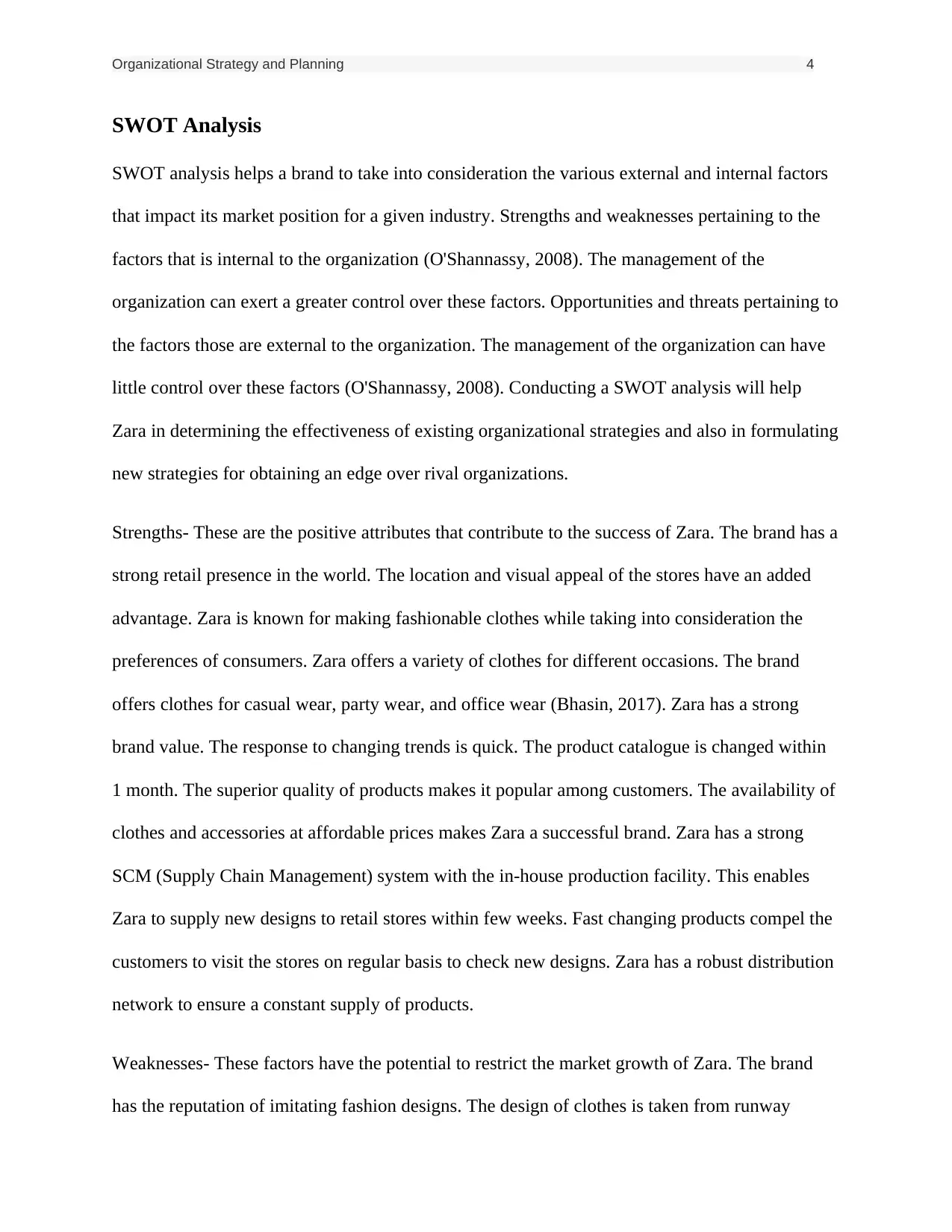
Organizational Strategy and Planning 4
SWOT Analysis
SWOT analysis helps a brand to take into consideration the various external and internal factors
that impact its market position for a given industry. Strengths and weaknesses pertaining to the
factors that is internal to the organization (O'Shannassy, 2008). The management of the
organization can exert a greater control over these factors. Opportunities and threats pertaining to
the factors those are external to the organization. The management of the organization can have
little control over these factors (O'Shannassy, 2008). Conducting a SWOT analysis will help
Zara in determining the effectiveness of existing organizational strategies and also in formulating
new strategies for obtaining an edge over rival organizations.
Strengths- These are the positive attributes that contribute to the success of Zara. The brand has a
strong retail presence in the world. The location and visual appeal of the stores have an added
advantage. Zara is known for making fashionable clothes while taking into consideration the
preferences of consumers. Zara offers a variety of clothes for different occasions. The brand
offers clothes for casual wear, party wear, and office wear (Bhasin, 2017). Zara has a strong
brand value. The response to changing trends is quick. The product catalogue is changed within
1 month. The superior quality of products makes it popular among customers. The availability of
clothes and accessories at affordable prices makes Zara a successful brand. Zara has a strong
SCM (Supply Chain Management) system with the in-house production facility. This enables
Zara to supply new designs to retail stores within few weeks. Fast changing products compel the
customers to visit the stores on regular basis to check new designs. Zara has a robust distribution
network to ensure a constant supply of products.
Weaknesses- These factors have the potential to restrict the market growth of Zara. The brand
has the reputation of imitating fashion designs. The design of clothes is taken from runway
SWOT Analysis
SWOT analysis helps a brand to take into consideration the various external and internal factors
that impact its market position for a given industry. Strengths and weaknesses pertaining to the
factors that is internal to the organization (O'Shannassy, 2008). The management of the
organization can exert a greater control over these factors. Opportunities and threats pertaining to
the factors those are external to the organization. The management of the organization can have
little control over these factors (O'Shannassy, 2008). Conducting a SWOT analysis will help
Zara in determining the effectiveness of existing organizational strategies and also in formulating
new strategies for obtaining an edge over rival organizations.
Strengths- These are the positive attributes that contribute to the success of Zara. The brand has a
strong retail presence in the world. The location and visual appeal of the stores have an added
advantage. Zara is known for making fashionable clothes while taking into consideration the
preferences of consumers. Zara offers a variety of clothes for different occasions. The brand
offers clothes for casual wear, party wear, and office wear (Bhasin, 2017). Zara has a strong
brand value. The response to changing trends is quick. The product catalogue is changed within
1 month. The superior quality of products makes it popular among customers. The availability of
clothes and accessories at affordable prices makes Zara a successful brand. Zara has a strong
SCM (Supply Chain Management) system with the in-house production facility. This enables
Zara to supply new designs to retail stores within few weeks. Fast changing products compel the
customers to visit the stores on regular basis to check new designs. Zara has a robust distribution
network to ensure a constant supply of products.
Weaknesses- These factors have the potential to restrict the market growth of Zara. The brand
has the reputation of imitating fashion designs. The design of clothes is taken from runway
Paraphrase This Document
Need a fresh take? Get an instant paraphrase of this document with our AI Paraphraser
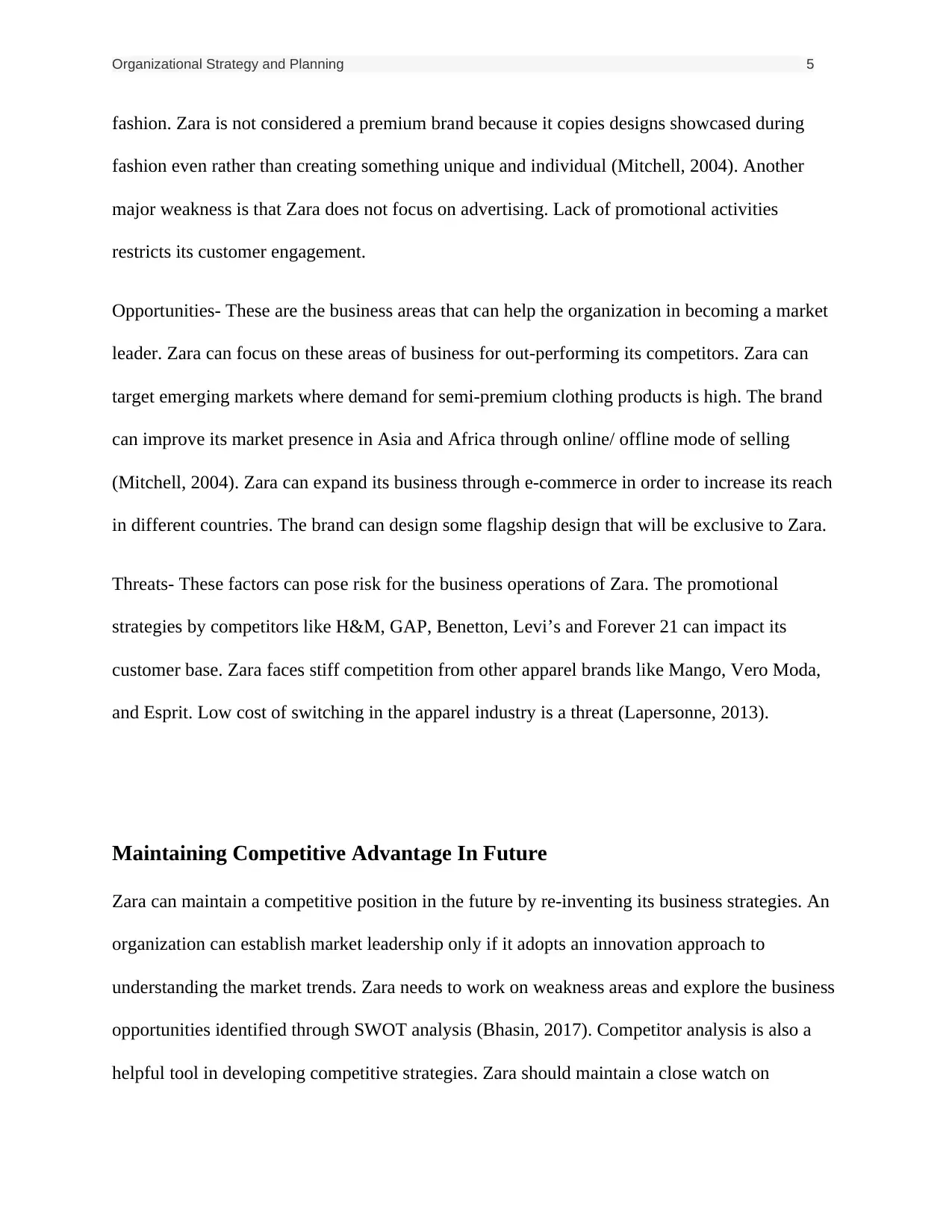
Organizational Strategy and Planning 5
fashion. Zara is not considered a premium brand because it copies designs showcased during
fashion even rather than creating something unique and individual (Mitchell, 2004). Another
major weakness is that Zara does not focus on advertising. Lack of promotional activities
restricts its customer engagement.
Opportunities- These are the business areas that can help the organization in becoming a market
leader. Zara can focus on these areas of business for out-performing its competitors. Zara can
target emerging markets where demand for semi-premium clothing products is high. The brand
can improve its market presence in Asia and Africa through online/ offline mode of selling
(Mitchell, 2004). Zara can expand its business through e-commerce in order to increase its reach
in different countries. The brand can design some flagship design that will be exclusive to Zara.
Threats- These factors can pose risk for the business operations of Zara. The promotional
strategies by competitors like H&M, GAP, Benetton, Levi’s and Forever 21 can impact its
customer base. Zara faces stiff competition from other apparel brands like Mango, Vero Moda,
and Esprit. Low cost of switching in the apparel industry is a threat (Lapersonne, 2013).
Maintaining Competitive Advantage In Future
Zara can maintain a competitive position in the future by re-inventing its business strategies. An
organization can establish market leadership only if it adopts an innovation approach to
understanding the market trends. Zara needs to work on weakness areas and explore the business
opportunities identified through SWOT analysis (Bhasin, 2017). Competitor analysis is also a
helpful tool in developing competitive strategies. Zara should maintain a close watch on
fashion. Zara is not considered a premium brand because it copies designs showcased during
fashion even rather than creating something unique and individual (Mitchell, 2004). Another
major weakness is that Zara does not focus on advertising. Lack of promotional activities
restricts its customer engagement.
Opportunities- These are the business areas that can help the organization in becoming a market
leader. Zara can focus on these areas of business for out-performing its competitors. Zara can
target emerging markets where demand for semi-premium clothing products is high. The brand
can improve its market presence in Asia and Africa through online/ offline mode of selling
(Mitchell, 2004). Zara can expand its business through e-commerce in order to increase its reach
in different countries. The brand can design some flagship design that will be exclusive to Zara.
Threats- These factors can pose risk for the business operations of Zara. The promotional
strategies by competitors like H&M, GAP, Benetton, Levi’s and Forever 21 can impact its
customer base. Zara faces stiff competition from other apparel brands like Mango, Vero Moda,
and Esprit. Low cost of switching in the apparel industry is a threat (Lapersonne, 2013).
Maintaining Competitive Advantage In Future
Zara can maintain a competitive position in the future by re-inventing its business strategies. An
organization can establish market leadership only if it adopts an innovation approach to
understanding the market trends. Zara needs to work on weakness areas and explore the business
opportunities identified through SWOT analysis (Bhasin, 2017). Competitor analysis is also a
helpful tool in developing competitive strategies. Zara should maintain a close watch on
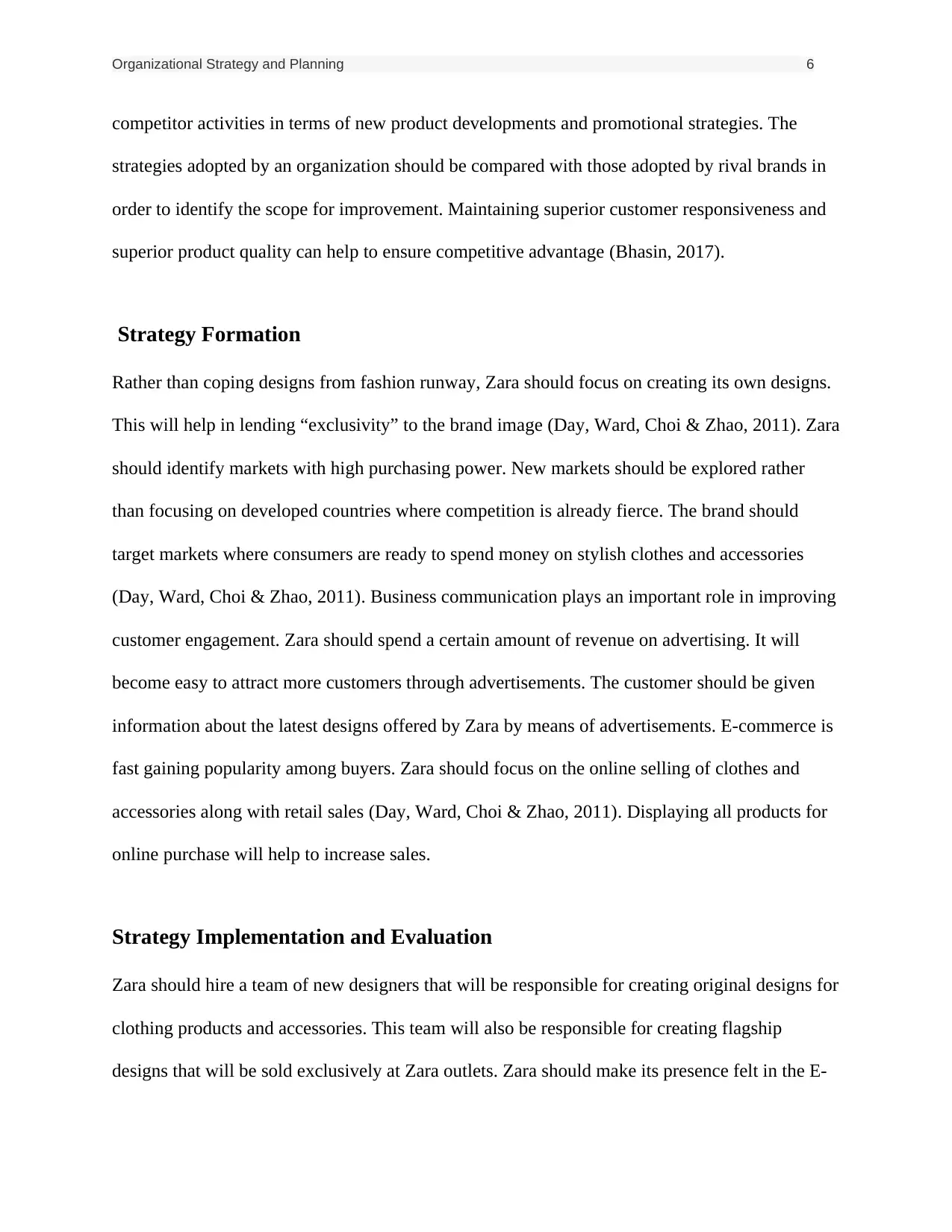
Organizational Strategy and Planning 6
competitor activities in terms of new product developments and promotional strategies. The
strategies adopted by an organization should be compared with those adopted by rival brands in
order to identify the scope for improvement. Maintaining superior customer responsiveness and
superior product quality can help to ensure competitive advantage (Bhasin, 2017).
Strategy Formation
Rather than coping designs from fashion runway, Zara should focus on creating its own designs.
This will help in lending “exclusivity” to the brand image (Day, Ward, Choi & Zhao, 2011). Zara
should identify markets with high purchasing power. New markets should be explored rather
than focusing on developed countries where competition is already fierce. The brand should
target markets where consumers are ready to spend money on stylish clothes and accessories
(Day, Ward, Choi & Zhao, 2011). Business communication plays an important role in improving
customer engagement. Zara should spend a certain amount of revenue on advertising. It will
become easy to attract more customers through advertisements. The customer should be given
information about the latest designs offered by Zara by means of advertisements. E-commerce is
fast gaining popularity among buyers. Zara should focus on the online selling of clothes and
accessories along with retail sales (Day, Ward, Choi & Zhao, 2011). Displaying all products for
online purchase will help to increase sales.
Strategy Implementation and Evaluation
Zara should hire a team of new designers that will be responsible for creating original designs for
clothing products and accessories. This team will also be responsible for creating flagship
designs that will be sold exclusively at Zara outlets. Zara should make its presence felt in the E-
competitor activities in terms of new product developments and promotional strategies. The
strategies adopted by an organization should be compared with those adopted by rival brands in
order to identify the scope for improvement. Maintaining superior customer responsiveness and
superior product quality can help to ensure competitive advantage (Bhasin, 2017).
Strategy Formation
Rather than coping designs from fashion runway, Zara should focus on creating its own designs.
This will help in lending “exclusivity” to the brand image (Day, Ward, Choi & Zhao, 2011). Zara
should identify markets with high purchasing power. New markets should be explored rather
than focusing on developed countries where competition is already fierce. The brand should
target markets where consumers are ready to spend money on stylish clothes and accessories
(Day, Ward, Choi & Zhao, 2011). Business communication plays an important role in improving
customer engagement. Zara should spend a certain amount of revenue on advertising. It will
become easy to attract more customers through advertisements. The customer should be given
information about the latest designs offered by Zara by means of advertisements. E-commerce is
fast gaining popularity among buyers. Zara should focus on the online selling of clothes and
accessories along with retail sales (Day, Ward, Choi & Zhao, 2011). Displaying all products for
online purchase will help to increase sales.
Strategy Implementation and Evaluation
Zara should hire a team of new designers that will be responsible for creating original designs for
clothing products and accessories. This team will also be responsible for creating flagship
designs that will be sold exclusively at Zara outlets. Zara should make its presence felt in the E-
⊘ This is a preview!⊘
Do you want full access?
Subscribe today to unlock all pages.

Trusted by 1+ million students worldwide
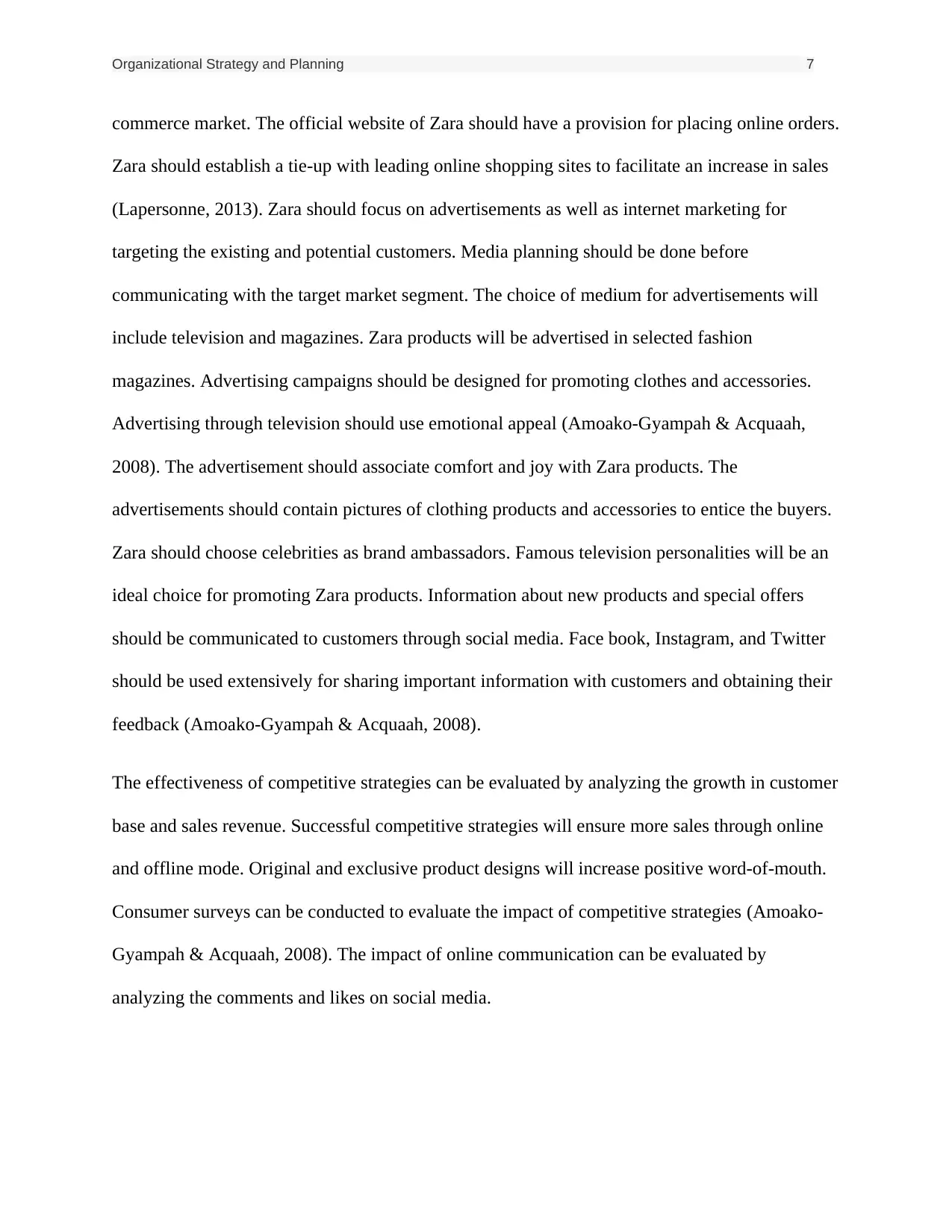
Organizational Strategy and Planning 7
commerce market. The official website of Zara should have a provision for placing online orders.
Zara should establish a tie-up with leading online shopping sites to facilitate an increase in sales
(Lapersonne, 2013). Zara should focus on advertisements as well as internet marketing for
targeting the existing and potential customers. Media planning should be done before
communicating with the target market segment. The choice of medium for advertisements will
include television and magazines. Zara products will be advertised in selected fashion
magazines. Advertising campaigns should be designed for promoting clothes and accessories.
Advertising through television should use emotional appeal (Amoako-Gyampah & Acquaah,
2008). The advertisement should associate comfort and joy with Zara products. The
advertisements should contain pictures of clothing products and accessories to entice the buyers.
Zara should choose celebrities as brand ambassadors. Famous television personalities will be an
ideal choice for promoting Zara products. Information about new products and special offers
should be communicated to customers through social media. Face book, Instagram, and Twitter
should be used extensively for sharing important information with customers and obtaining their
feedback (Amoako-Gyampah & Acquaah, 2008).
The effectiveness of competitive strategies can be evaluated by analyzing the growth in customer
base and sales revenue. Successful competitive strategies will ensure more sales through online
and offline mode. Original and exclusive product designs will increase positive word-of-mouth.
Consumer surveys can be conducted to evaluate the impact of competitive strategies (Amoako-
Gyampah & Acquaah, 2008). The impact of online communication can be evaluated by
analyzing the comments and likes on social media.
commerce market. The official website of Zara should have a provision for placing online orders.
Zara should establish a tie-up with leading online shopping sites to facilitate an increase in sales
(Lapersonne, 2013). Zara should focus on advertisements as well as internet marketing for
targeting the existing and potential customers. Media planning should be done before
communicating with the target market segment. The choice of medium for advertisements will
include television and magazines. Zara products will be advertised in selected fashion
magazines. Advertising campaigns should be designed for promoting clothes and accessories.
Advertising through television should use emotional appeal (Amoako-Gyampah & Acquaah,
2008). The advertisement should associate comfort and joy with Zara products. The
advertisements should contain pictures of clothing products and accessories to entice the buyers.
Zara should choose celebrities as brand ambassadors. Famous television personalities will be an
ideal choice for promoting Zara products. Information about new products and special offers
should be communicated to customers through social media. Face book, Instagram, and Twitter
should be used extensively for sharing important information with customers and obtaining their
feedback (Amoako-Gyampah & Acquaah, 2008).
The effectiveness of competitive strategies can be evaluated by analyzing the growth in customer
base and sales revenue. Successful competitive strategies will ensure more sales through online
and offline mode. Original and exclusive product designs will increase positive word-of-mouth.
Consumer surveys can be conducted to evaluate the impact of competitive strategies (Amoako-
Gyampah & Acquaah, 2008). The impact of online communication can be evaluated by
analyzing the comments and likes on social media.
Paraphrase This Document
Need a fresh take? Get an instant paraphrase of this document with our AI Paraphraser
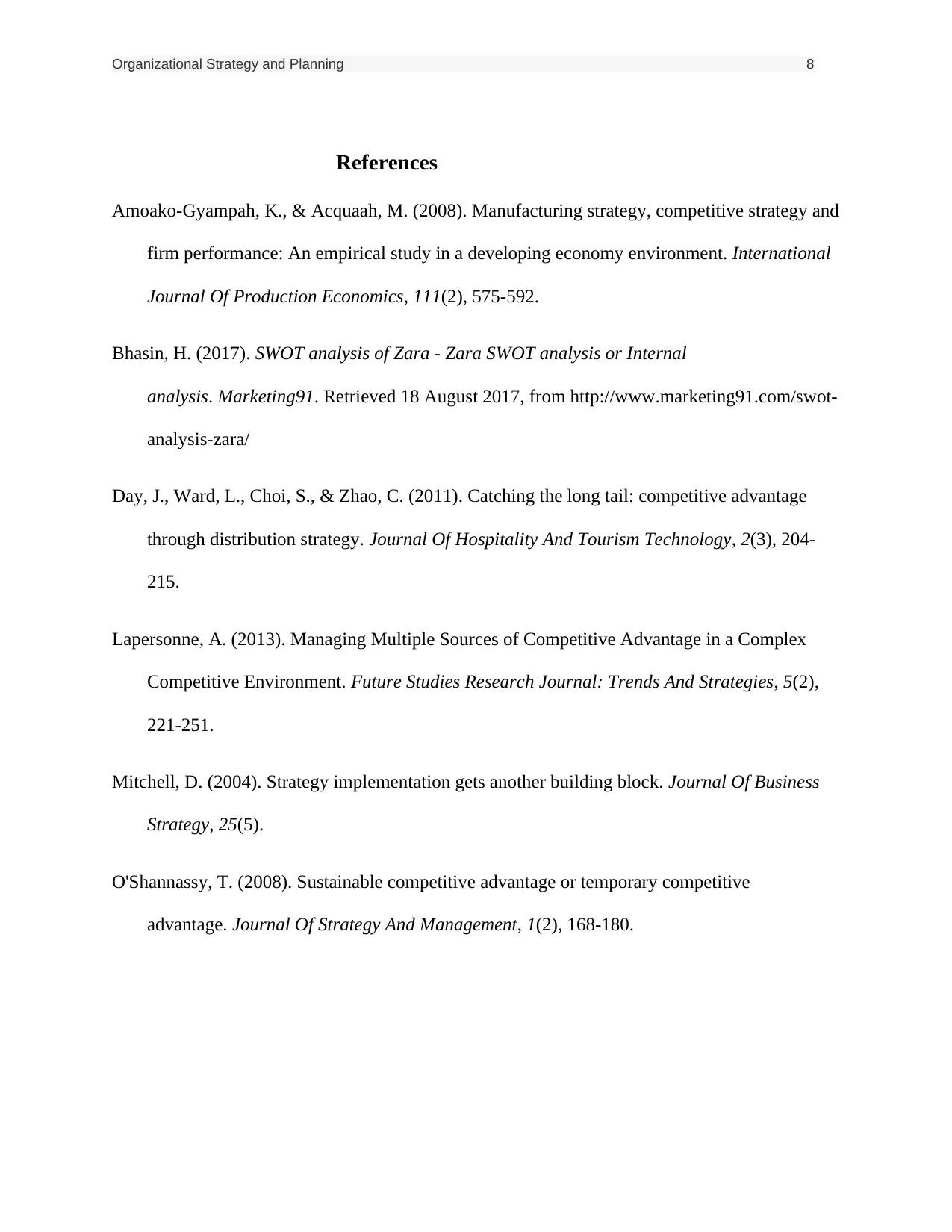
Organizational Strategy and Planning 8
References
Amoako-Gyampah, K., & Acquaah, M. (2008). Manufacturing strategy, competitive strategy and
firm performance: An empirical study in a developing economy environment. International
Journal Of Production Economics, 111(2), 575-592.
Bhasin, H. (2017). SWOT analysis of Zara - Zara SWOT analysis or Internal
analysis. Marketing91. Retrieved 18 August 2017, from http://www.marketing91.com/swot-
analysis-zara/
Day, J., Ward, L., Choi, S., & Zhao, C. (2011). Catching the long tail: competitive advantage
through distribution strategy. Journal Of Hospitality And Tourism Technology, 2(3), 204-
215.
Lapersonne, A. (2013). Managing Multiple Sources of Competitive Advantage in a Complex
Competitive Environment. Future Studies Research Journal: Trends And Strategies, 5(2),
221-251.
Mitchell, D. (2004). Strategy implementation gets another building block. Journal Of Business
Strategy, 25(5).
O'Shannassy, T. (2008). Sustainable competitive advantage or temporary competitive
advantage. Journal Of Strategy And Management, 1(2), 168-180.
References
Amoako-Gyampah, K., & Acquaah, M. (2008). Manufacturing strategy, competitive strategy and
firm performance: An empirical study in a developing economy environment. International
Journal Of Production Economics, 111(2), 575-592.
Bhasin, H. (2017). SWOT analysis of Zara - Zara SWOT analysis or Internal
analysis. Marketing91. Retrieved 18 August 2017, from http://www.marketing91.com/swot-
analysis-zara/
Day, J., Ward, L., Choi, S., & Zhao, C. (2011). Catching the long tail: competitive advantage
through distribution strategy. Journal Of Hospitality And Tourism Technology, 2(3), 204-
215.
Lapersonne, A. (2013). Managing Multiple Sources of Competitive Advantage in a Complex
Competitive Environment. Future Studies Research Journal: Trends And Strategies, 5(2),
221-251.
Mitchell, D. (2004). Strategy implementation gets another building block. Journal Of Business
Strategy, 25(5).
O'Shannassy, T. (2008). Sustainable competitive advantage or temporary competitive
advantage. Journal Of Strategy And Management, 1(2), 168-180.
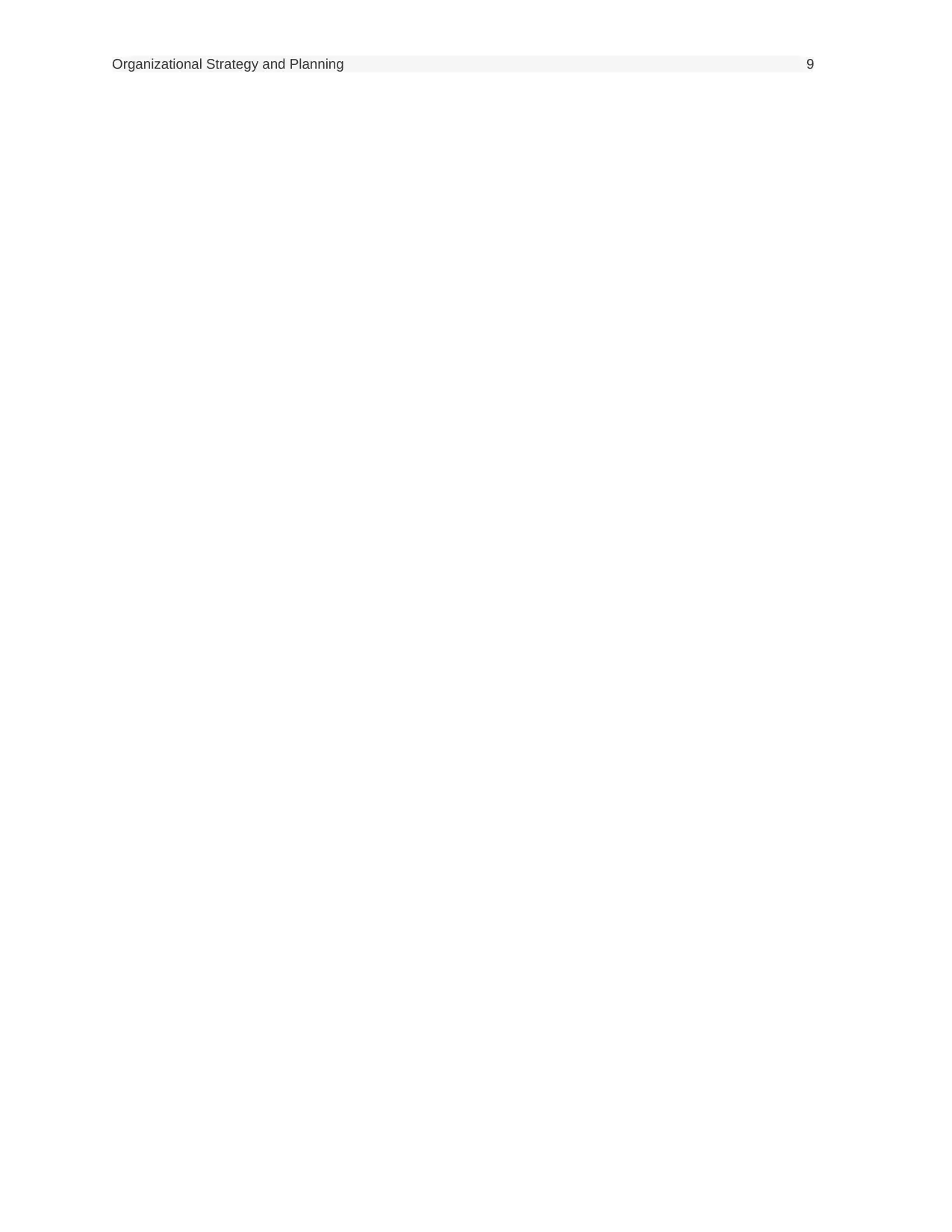
Organizational Strategy and Planning 9
⊘ This is a preview!⊘
Do you want full access?
Subscribe today to unlock all pages.

Trusted by 1+ million students worldwide
1 out of 9
Related Documents
Your All-in-One AI-Powered Toolkit for Academic Success.
+13062052269
info@desklib.com
Available 24*7 on WhatsApp / Email
![[object Object]](/_next/static/media/star-bottom.7253800d.svg)
Unlock your academic potential
Copyright © 2020–2025 A2Z Services. All Rights Reserved. Developed and managed by ZUCOL.





